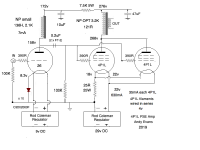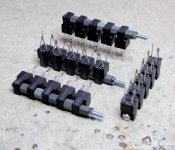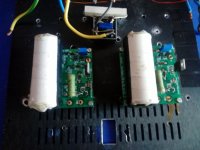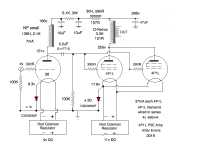Thanks buddy,
Still lots to learn from you.
I think there is room to tweak it better. I let it burn in for a while then report again.
Still lots to learn from you.
I think there is room to tweak it better. I let it burn in for a while then report again.
I started out trying the A2 drive but not successful with 6n6p. I really would like to try with your design but don't have that transistor in hand. Can I substitute with other one like ixtp08n100d2 or..
Albert
Sure, it will work!
And since it is a depletion mode MOSFET, you do not need a gate voltage source, like in my first experiment that I started the thread with.
Today I would rather use a MOSFET source follower instead of a cathode follower that I used then.
A2 driving boards (for tube amps)
I have so many amp and preamp stages on the go. So far I just use the 4P1L PSE output stage in filament bias. I intend to try this with SIC diode bias.
The input stage varies. Recently I tried a 6C4C stage in SIC bias which was good in its way but lacked the magic of the 26 in SIC bias. The last input stage I tried was a 10Y in SIC bias which was very good, and I'll be coming back to that one.
I've been listening to Brahms 2 and 3 with Columbia/Walter and really liking the orchestral sound. It's quite lush but still detailed. Really nice.
The input stage varies. Recently I tried a 6C4C stage in SIC bias which was good in its way but lacked the magic of the 26 in SIC bias. The last input stage I tried was a 10Y in SIC bias which was very good, and I'll be coming back to that one.
I've been listening to Brahms 2 and 3 with Columbia/Walter and really liking the orchestral sound. It's quite lush but still detailed. Really nice.
Nicely done! Quite clever mounting arrangement.
I'm planning on building Ale's 6e5p driven 4p1l pse later this year, curious what driver(s) you're planning on using?
Cheers,
Gable
I'm planning on building Ale's 6e5p driven 4p1l pse later this year, curious what driver(s) you're planning on using?
Cheers,
Gable
The Schematic is 4 posts back, 1183. My standard driver stage is 26 in SIC bias. I've also used 10Y which is very nice. I only use DHTs as drivers, and just 2 stages total.
For the 6e5p driver, you are going indirectly heated. You will lose a little quality over the 26 but you will get more gain if you need that. It's a good driver for an indirectly heated tube - haven't compared it directly with a 2C22 which is another good one. I heard the 6e5p as part of a preamp shootout we did at Ale's. Using it in SIC bias should improve it again.
For the 6e5p driver, you are going indirectly heated. You will lose a little quality over the 26 but you will get more gain if you need that. It's a good driver for an indirectly heated tube - haven't compared it directly with a 2C22 which is another good one. I heard the 6e5p as part of a preamp shootout we did at Ale's. Using it in SIC bias should improve it again.
Mine couple stacks of 10 C3D02060F + 120R Shinkoh ready to bias the 26 preamp.
You don't need the resistor. Try with and without. Mine sounded better without.
Thanks Andy what B+ for with & without resitor?
Schematic is back in post 1138.
You can work out your preferred operating point using the curves and Ohms law. The schematic above shows one version. I'm shooting for 7mA since this is driving the outputs. More current in a driver would be better but I like the sound of the 26. You can put more current through the 10Y, but that gets expensive.
For the PSE 4P1L output stage, a string of 20 C3D02060F SIC diodes gives me 17.8v. Just tried it. I'm just finishing off the 26 input stage. Eager to hear this amp, which has the small "Commercial" 3.3K O'Netics OPTs instead of the Level 1 O'Netics 3.2K shown above.
For the PSE 4P1L output stage, a string of 20 C3D02060F SIC diodes gives me 17.8v. Just tried it. I'm just finishing off the 26 input stage. Eager to hear this amp, which has the small "Commercial" 3.3K O'Netics OPTs instead of the Level 1 O'Netics 3.2K shown above.
Last edited:
Well, finished the build with O-Netics 3.3K "Commercial" OPT. The output stage is now in SIC diode bias. I have mixed feelings about the result. Using these SIC diodes you get more clarity and low level detail, but the sound can take on a certain hardness, almost stridency. For the input 26 stage this seems acceptable, as long as the outputs are in filament bias.
I was pretty comfortable with the amp outlined in post 1183. When you have 2 stages in SIC diode bias the sound gets more edgy. This is a shame because the added low level detail is most welcome, and voices can sound very intimate. I was liking it more on jazz vocals. Orchestral music was less satisfying - I lost the sheen on the strings and the overall sound wasn't smooth enough.
Right now I think I'll be going back to filament bias in the outputs unless I can come up with an ultra smooth driver stage. I can use the 10Y here and that would give a lot more current as a driver than the 7mA I'm using with the 26. The 6C4C stage I built was the smoothest (all in SIC diode bias here) but wasn't very exciting. I'll listen some more to this new amp but I'm not convinced, unfortunately, even though it does some things better.
I was pretty comfortable with the amp outlined in post 1183. When you have 2 stages in SIC diode bias the sound gets more edgy. This is a shame because the added low level detail is most welcome, and voices can sound very intimate. I was liking it more on jazz vocals. Orchestral music was less satisfying - I lost the sheen on the strings and the overall sound wasn't smooth enough.
Right now I think I'll be going back to filament bias in the outputs unless I can come up with an ultra smooth driver stage. I can use the 10Y here and that would give a lot more current as a driver than the 7mA I'm using with the 26. The 6C4C stage I built was the smoothest (all in SIC diode bias here) but wasn't very exciting. I'll listen some more to this new amp but I'm not convinced, unfortunately, even though it does some things better.
Attachments
Last edited:
More than 2 weeks I've been listening to the output stage of Mr. Andy's amplifier and I like it. First it was just output stage but there was no enough gain. I borrowed stepup trafos from a friend, removed the input capacitors, and the sound became more beautiful and there is enough gain.
Thanks Mr. Andy, Mr.Rod, Mr. Zelimir and Mr. Sale for your help.
Thanks Mr. Andy, Mr.Rod, Mr. Zelimir and Mr. Sale for your help.
Hello guys, I plan about building mine 4p1l SE. I can use indirectly heated tubes as driver - e180f or 6n6p which I have on hand. I have also E422 dhts (equivalent is re134), but I have only 2 of these - one will die and I will have nothing to replace it....
My question is (I couldnt find it here) , can I use 4P1L with ac heating for first tests with hum potentiometer? will the hum be audible? (I heard 300b amp with ac heating and the speakers were ABSOLUTELY quiet - will it also work with 4P1L?)
I plan to use fixed bias.
Also, my output transformers originally runned in radio with 25mA current. I know that sound when passing 40mA DC is absolutely good even on bass, but Im scared to do something like 60-70mA (reason why I cant do paralell SE).
And Im little bit uncertain if the 4P1Ls will sound good if one will be biased on 20mA with 290V b+. For me this is too low.
Or do you think that I can use one 4P1L and little bit overheat it, something like 280 volts 35mA?
Best regards and thank you for answering 🙂
My question is (I couldnt find it here) , can I use 4P1L with ac heating for first tests with hum potentiometer? will the hum be audible? (I heard 300b amp with ac heating and the speakers were ABSOLUTELY quiet - will it also work with 4P1L?)
I plan to use fixed bias.
Also, my output transformers originally runned in radio with 25mA current. I know that sound when passing 40mA DC is absolutely good even on bass, but Im scared to do something like 60-70mA (reason why I cant do paralell SE).
And Im little bit uncertain if the 4P1Ls will sound good if one will be biased on 20mA with 290V b+. For me this is too low.
Or do you think that I can use one 4P1L and little bit overheat it, something like 280 volts 35mA?
Best regards and thank you for answering 🙂
According to my experience 11 w is maximum after that is starts getting red.
Can not say about ac filament, I did not try.
Can not say about ac filament, I did not try.
I've never exceeded 250v a-k with the 4P1L - that's what the data says. I think Ale Moglia tried it hotter but then went back to around 250v a-k. Something on his blog Bartola Valves maybe. But with 250v a-k you can certainly use 35mA. Try it and see if you like it. I always use Rod Coleman regulators for the 4P1L, as do most readers here I think. Not expensive and well worth it. I would use filament bias so you don't need a cathode bypass cap. Plenty of schematics on this thread.
Even if you change to another output tube like 300b etc, Rod's regs are still good. But the 300b won't be in filament bias. That's just a trick you can use with the 4P1L because of the low bias voltage.
Even if you change to another output tube like 300b etc, Rod's regs are still good. But the 300b won't be in filament bias. That's just a trick you can use with the 4P1L because of the low bias voltage.
- Home
- Amplifiers
- Tubes / Valves
- One more 4P1L SE




